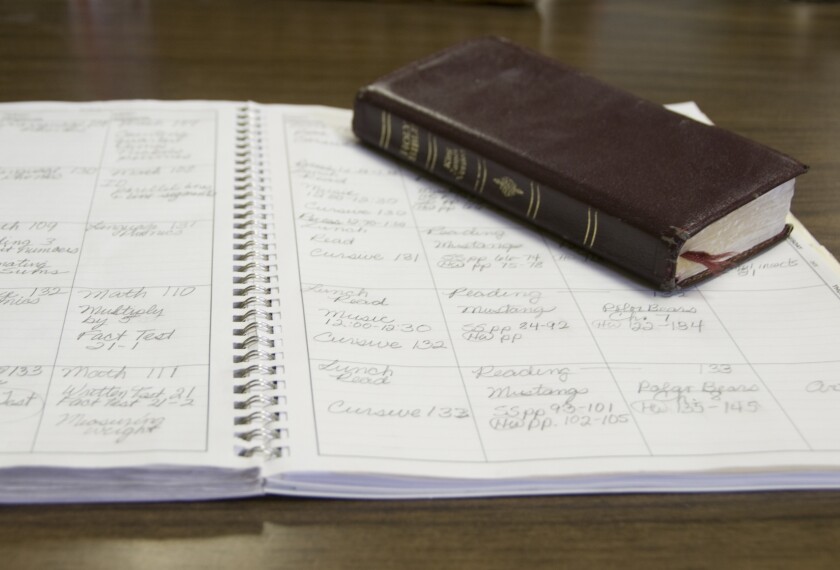When California announced a free digital-textbook initiative earlier this year for high school math and science courses across the state, it fueled predictions of the impending demise of the hardcover schoolbook.
“Schwarzenegger Terminates Textbooks,” shouted one newspaper headline, referring to Gov. Arnold Schwarzenegger’s push for open online resources as a way to address the state’s budget crisis.
The speculation was a bit premature, experts say, given the limited scope of the effort. But such a move in one of the nation’s most influential school publishing markets, along with changes in textbook policies in other key states, could speed up the availability and acceptance of high-quality free and commercial digital resources for K-12 classes.
“As far as replacing textbooks, I don’t think there is a threat of that happening yet, but California is giving the green light to publishers and others to try and build the digital resources schools need,” says Keith Krueger, the chief executive officer of the Consortium for School Networking, or CoSN, based in Washington.
Should schools replace paper textbooks with digital versions? What are the potential downsides of going in that direction?
California isn’t the first state to seek out more digital options in school curricula. Earlier this year, Texas, which rivals California in textbook spending at as much as a half-billion dollars a year, approved legislation that expands the state’s definition of instructional materials to free online resources that meet academic requirements. Florida and Indiana have approved similar changes in the kinds of texts districts can buy with state money.
‘Try New Things’
“The fact that these states gave out a directive that textbook money can be spent on any content, including digital content, gives districts an opportunity to try new things and deliver instruction in new ways,” Krueger says.
The Web has become a treasure trove of free and commercial educational resources over the past several years, providing ample choices for teachers and curriculum leaders looking for up-to-date content that integrates multimedia and interactive tools.
A number of nonprofit organizations, commercial publishers, and individual educators have built online collections of materials for the classroom, from complete courses to supplemental materials.
But there is some debate about how much, if any, money will be saved in the transition to digital texts. If schools use all free resources, they could potentially save on the cost of textbooks, but theywill need technological devices to access them, staff resources to find and review them, and professional development for teachers to use them effectively. Finding sufficient materials in various subjects, aligned to state standards, and in a usable format, could prove difficult at this point.
Publishers have been struggling to help educators make the transition, and many have offered digital programs alongside print products for years. Most districts, however, are not ready to abandon print materials, and even those that adopt digital texts want print editions in case the technology is not available, according to Peter Cohen, the chief executive officer for pre-K-12 curriculum at Pearson 91��Ƭ����Ƶ, one of the largest textbook publishers in the world.
“Five years ago, we offered a fully digital text edition in California for the social studies program that could be delivered 100 percent online,” he points out. But most districts did not have the necessary range of tech tools—such as a computer for each student or interactive whiteboards—to make full use of the program, and fell back on the print edition instead.
“It was really well received philosophically,” Cohen says, “but very little use was actually made of the digital portion of the text.”
Some lawmakers want to change that reality. Scott Hochberg, a state representative in Texas, sponsored legislation that passed this year that allows free online textbooks to be vetted through the state’s instructional-materials review process. Hochberg, a Democrat from Houston, says the policy allows the state to look to free and lower-cost curricula outside the commercial publishing industry, and to create a repository of new resources for schools.
‘The Best Way’
As technology evolves, and demands increase for a curriculum that builds both content knowledge and higher-order skills for the 21st century, some observers argue that such decisions should be driven more by innovation than economics.
“Let’s step back and ask, ‘For today’s kids, what’s the best way to provide content?’ ” Krueger says. “You probably wouldn’t answer, ‘The traditional textbook.’ ”
Krueger, who is leading CoSN’s “open technologies” initiative to highlight best practices in developing and using free digital resources, sees the most promise in electronic resources that tap a range of technologies to present content in a rich, engaging manner.
“All too often, what’s called digital content is simply digitizing a piece of work, a traditional textbook,” he says. “That’s really not tapping into the best technology has to offer.”
California has a way to go toward transforming content in a digitalformat, observers say. The state initiative called for comprehensive high school texts in a PDF format, meaning an online text-based product that can be printed out.
“Right now, a digital textbook in any format, be it PDF or ePUB [an open-source eReader format] is still flat and linear, not unlike the card catalogs our libraries used to have,” says Brian Bridges, the director of the California Learning Resource Network, which conducted the reviews for the state’s digital-textbook initiative. “They’re not very removed from a physical book.”
Bridges, however, envisions better products in the future as the field evolves.
“I do think that a variety of technologies and content formats will converge,” he says, “to create a new learning resource.”




